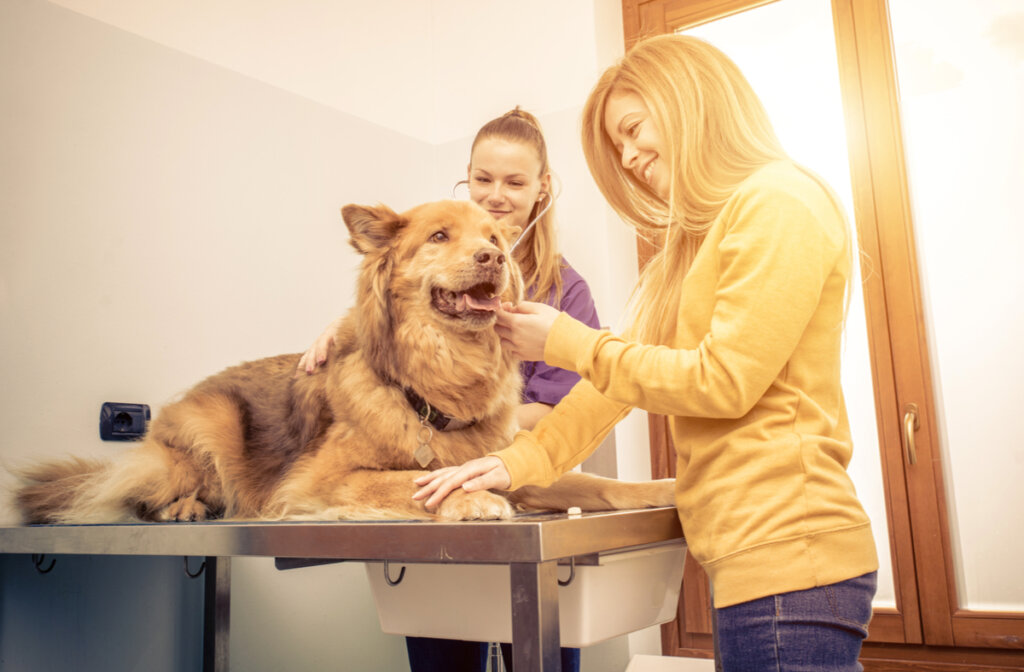Prostatitis in Dogs: Symptoms and Treatment

The prostate, the only accessory sex gland that male canines have, is located inside the pelvic cavity, and surrounds the urethra. When it becomes inflamed for any reason, we’re talking about prostatitis in dogs. Treating it is essential, as it can have serious effects if it becomes chronic.
In addition to producing the fluid that transports sperm to the outside of the body, the prostate has an antibacterial function, as it washes the urethra during urination. In this article, we’ll tell you all about the importance of this gland and how to treat it when it becomes inflamed. Don’t miss it.
What is prostatitis in dogs?
Prostatitis is the name given to the inflammatory process of the prostate tissue, which is usually of infectious origin. It can occur in both neutered dogs and those with their gonads intact, but it’s less severe in the former, as the prostate reduces in size after neutering.
The cause of the infection usually comes from the outside, i.e. it reaches the prostate through the urethra. This inflammation can be acute or chronic, depending on its duration and the affected area. Below we’ll show you its universal classification:
- Acute prostatitis: The entire glandular tissue is affected. The infection may have come through the blood (and not from outside the body) if the dog has generalized bacteremia (presence of microorganisms in the bloodstream).
- Chronic prostatitis: This usually takes the form of abscesses (accumulations of encapsulated pus) and is the result of the prolongation of acute infection. However, it can occur without a previously diagnosed pathology.

Causes of the disease
The main cause of this inflammation, as discussed above, is infectious. The most common bacteria that cause prostatitis in dogs are the following:
- Escherichia coli: This is the typical type of infection.
- Mycoplasma and Brucella canis: These are the causative agents of canine brucellosis. Although they’re less frequent than E. coli, they should be detected in time, as they can cause sterility in the dog.
- Bacteria of the Staphylococcus and Streptococcus family.
- Genus Proteus: These are bacteria often found in urinary tract infections.
- Klebsiella: Despite being enterobacteria, they could reach the prostate through the bloodstream.
- Pseudomonas: These bacilli are present in the environment and animals usually have defenses against them, but they could infect an immunosuppressed specimen.
There are also a number of factors that predispose the animal to secondary prostatitis. The most important is benign prostatic hyperplasia, a very common pathology in older dogs that consists of an enlarged prostate (not to be confused with inflammation).
Cysts, stones in the urethra, or urinary tract infections are also possible causes of prostatitis in dogs.
Symptoms of the disease
The signs of prostatitis in dogs are typical of a urinary tract infection, with some considerations. Here you can read the specific symptoms of this ailment:
- Fever
- Anorexia (lack of appetite)
- Lethargy
- Infertility: As the prostate produces the fluid that transports the spermatozoa in the ejaculate fluid, the presence of bacterial toxins will alter its composition, killing the gametes.
- Hematuria (blood in the urine).
- Purulent urethral discharge.
- Constipation: The enlarged prostate is able to compress the rectal tract and thus prevent the passage of stools.
- Dysuria (difficulty urinating).
- Peritonitis: If there are abscesses in the prostate and one of them ruptures, the bacteria will remain free in the peritoneum, the membrane that surrounds and protects the viscera. This could cause septicemia and threaten the animal’s life.
Diagnosis of prostatitis in dogs
To diagnose this infection, several tests are necessary, because you have to rule out other ailments that give similar symptoms or, on the contrary, that could be the cause of the prostatitis. Here are the most basic ones:
- Rectal palpation: In this way, the inflammation of the prostate is detected, because in the chronic disease, it’s much harder and cysts and abscesses can be easily found.
- X-rays: With this test, the enlargement of the prostate and the mineralization of the urethra can be directly observed.
- Ultrasound: This is the test par excellence, as it’s the least invasive and safest for the dog. It’s also possible to detect cysts and abscesses, as well as calcifications and fibrosis.
- Blood analysis: Thanks to this test, the increase of white blood cells in the blood is detected, as well as other significant values, such as protein and alanine aminotransferase.
- Urinalysis: The urine also contains white blood cells, red blood cells (in the case of haematuria), and the bacteria themselves. You can make the dog ejaculate to also analyze the prostatic fluid, but this isn’t recommended because it’s very painful in this state.
- Culture and antibiogram: From the same urine or prostatic fluid, it’s possible to perform a culture to find out what specific bacteria are affecting the prostate. Depending on which bacteria are found, an antibiogram will be carried out to find the most appropriate antibiotic.
- Fine needle aspiration: This is a way of taking a biopsy of the prostate in order to study the tissue. However, it isn’t recommended in cases that have abscesses, as they could break on contact with the needle.
Treatment
Since it’s a bacterial infection, the main treatment consists of the administration of antibiotics. If there’s a culture and an antibiogram (which would be ideal), you can choose the most appropriate drugs for each case. The duration of treatment is 4-8 weeks depending on its severity.
When prostatitis is chronic, the antibiotic must be able to cross the blood-prostatic barrier or it won’t work.
Another option is surgery, which is recommended in cases of prostatitis arising from benign prostatic hyperplasia. The most appropriate solution for both health problems is castration, as it solves them both in the short and long term.

Prostatitis in dogs can be life-threatening if not treated in time. In addition, the possible underlying pathologies to this infection are an added problem to diagnose and treat. Therefore, if you detect symptoms of urinary problems in your dog (whatever they are), don’t hesitate to go to your trusted veterinarian.
All cited sources were thoroughly reviewed by our team to ensure their quality, reliability, currency, and validity. The bibliography of this article was considered reliable and of academic or scientific accuracy.
- Dranonetti, A., Solis, C., Giordano, A. (2005). Prostatitis en el perro. Analecta Veterinaria; 25(1)33-39.
- Johnston S.D., Root K.M.V., Olson P.N. (2001). Disorders of the canine prostate. Canine and Feline Theriogenology. Saunders; 337- 355.
- González, G., Maffrand, C., Guendulain, C., Caffaratti, M., Galetto, M., & Gobello, C. (2010). Sensibilidad y especificidad de la aspiración biopsia con aguja fina guiada por ecografía para el diagnóstico de hiperplasia prostática y prostatitis crónica canina. Revista cientifica, 20(6), 617-622.